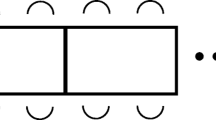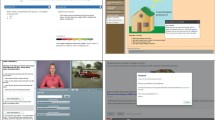Abstract
In order to evaluate the effectiveness of an experimental elementary mathematics field experience course, we have designed a new assessment instrument. These video-based prediction assessments engage prospective teachers in a video analysis of a child solving mathematical tasks. The prospective teachers build a model of that child’s mathematics and then use that model to predict how the child will respond to a subsequent task. In this paper, we share data concerning the evolution and effectiveness of the instrument. Results from implementation indicate moderate to high degrees of inter-rater reliability in using the rubric to assess prospective teachers’ models and predictions. They also indicate strong correlation between participation in the experimental course and prospective teachers’ performances on the video-based prediction assessments. Such findings suggest that prediction assessments effectively evaluate the pedagogical content knowledge that we are seeking to foster among the prospective teachers.


Similar content being viewed by others
References
Arbaugh, F., & Brown, C. A. (2005). Analyzing mathematical tasks: A catalyst for change? Journal of Mathematics Teacher Education, 8(6), 499–536.
Ball, D. L. (1994, November). Developing mathematics reform: What don’t we know about teacher learning—but would make good working hypotheses? Paper presented at Conference on Teacher Enhancement in Mathematics K–6, Arlington, VA.
Carpenter, T. P., Fennema, E., Peterson, P. L., & Carey, D. A. (1988). Teachers’ pedagogical content knowledge of students’ problem solving in elementary arithmetic. Journal for Research in Mathematics Education, 19, 385–401.
Chamberlin, M. T. (2005). Teachers’ discussions of students’ thinking: Meeting the challenge of attending to students’ thinking. Journal of Mathematics Teacher Education, 8, 141–170.
Cochran-Smith, M., & Zeichner, K. M. (Eds.). (2005). Studying teacher education: The report of the AERA panel on research and teacher education. Mahwah, NJ: Lawrence Erlbaum.
Confrey, J. (1988). Multiplication and splitting: Their role in understanding exponential functions. Paper presented at the tenth annual meeting of the North American chapter of the international group for the psychology of mathematics education, DeKalb, IL.
Confrey, J. (1993). Learning to see children’s mathematics: Crucial challenges in constructivist reform. In K. Tobin (Ed.), Constructivist perspectives in science and mathematics (pp. 299–321). Washington, DC: American Association for the Advancement of Science.
Confrey, J. (1994). Splitting, similarity and rate of change: A new approach to multiplication and exponential functions. In G. Harel & J. Confrey (Eds.), The development of multiplicative reasoning in the learning of mathematics (pp. 291–330). Albany: State University of New York.
Confrey, J., & Lachance, A. (2000). Transformative teaching experiments through conjecture driven research design. In A. E. Kelly & R. A. Lesh (Eds.), Handbook of research design in mathematics and science education (pp. 231–265). Mahwah, NJ: Lawrence Erlbaum.
Crespo, S. (2000). Seeing more than right and wrong answers: Prospective teachers’ interpretations of students’ mathematical work. Journal of Mathematics Teacher Education, 3(2), 155–181.
Crespo, S., & Nicol, C. (2003). Learning to investigate students’ mathematical thinking: The role of student interviews. In N. A. Pateman, B. J. Dougherty, & J. Zilliox (Eds.), Proceedings of the 2003 joint meeting of PME and PMENA (Vol. 2, pp. 261–267). Honolulu: College of Education, University of Hawaii.
Davis, B. (1997). Listening for differences: An evolving conception of mathematics teaching. Journal for Research in Mathematics Education, 28(3), 355–376.
diSessa, A. A. (2007). An interactional analysis of clinical interviewing. Cognition and Instruction, 25(4), 523–565.
Education Commission of the States. (2003a). Eight questions on teacher preparation: What does the research say? Retrieved July, 2006, from www.ecs.org/tpreport.
Education Commission of the States. (2003b). Eight questions on teacher preparation: What does the research say? A summary of the findings. Retrieved July, 2006, from http://www.ecs.org/ecsmain.asp?page=/html/educationIssues/teachingquality/tpreport/.
Educational Testing Service (2006). State requirements. Retrieved June 27, 2006, from http://www.ets.org/portal/site/ets/menuitem.22f30af61d34e9c39a77b13bc3921509/vgnextoid=d378197a484f4010VgnVCM10000022f95190RCRD.
Fennema, E., Carpenter, T. P., Franke, M. L., Levi, L., Jacobs, V. R., & Empson, S. B. (1996). A longitudinal study of learning to use children’s thinking in mathematics instruction. Journal for Research in Mathematics Education, 27, 403–434.
Franke, M. L., Carpenter, T. P., Levi, L., & Fennema, E. (2001). Capturing teachers’ generative change: A follow-up study of professional development in mathematics. American Educational Research Journal, 38(3), 653–689.
Goodman, L., & Kruskal, W. (1954). Measures of associations for cross-validations. Journal of the American Statistical Association, 49, 732–764.
Hill, H. C., Ball, D. L., & Schilling, S. G. (2008). Unpacking pedagogical content knowledge: Conceptualizing and measuring teachers’ topic-specific knowledge of students. Journal for Research in Mathematics Education, 39(4), 372–400.
Hill, H. C., Schilling, S. G., & Ball, D. L. (2004). Developing measures of teachers’ mathematics knowledge for teaching. Elementary School Journal, 105, 11–30.
Kane, T. J., Rockoff, J. E., & Staiger, D. O. (2006). What does certification tell us about teacher effectiveness? Evidence from New York City. Retrieved July, 2006, from http://gseweb.harvard.edu/news/features/kane/nycfellowsmarch2006.pdf.
Kersting, N. (2008). Using video clips of mathematics classroom instruction as item prompts to measure teachers’ knowledge of teaching mathematics. Educational and Psychological Measurement, 68(5), 845–861.
Koirala, H. P., Davis, M., & Johnson, P. (2008). Development of a performance assessment task and rubric to measure prospective secondary school mathematics teachers’ pedagogical content knowledge and skills. Journal of Mathematics Teacher Education, 11, 127–138.
Landis, J. R., & Koch, G. G. (1977). The measurement of observer agreement for categorical data. Biometrics, 33, 159–174.
Lewis, C. C. (2000, April). Lesson study: The core of Japanese professional development. Invited presentation to the Special Interest Group on Research in Mathematics Education at the annual meeting of the American Educational Research Association, New Orleans, LA.
No Child Left Behind of 2001. (2001, January). Public Law No. 107–110, 107th Congress. Retrieved from http://www.ed.gov/legislation/ESEA02/.
Norton, A. H., & McCloskey, A. (2008). Teaching experiments and professional development. Journal of Mathematics Teacher Education, 11(4), 285–305.
Olive, J. (2000). Computer tools for interactive mathematical activity in the elementary school. International Journal of Computers for Mathematics Learning, 5, 241–262.
Philipp, R. A., Ambrose, R., Lamb, L. L. C., Sowder, J. T., Schappelle, B. P., Sowder, L., et al. (2007). Effects of early field experiences on the mathematical content knowledge and beliefs of prospective elementary school teachers: An experimental study. Journal for Research in Mathematics Education, 38(5), 438–476.
Piaget, J. (1970). Science of education and the psychology of the child. New York: Viking Press.
Schifter, D. (1998). Learning mathematics for teaching: From the teachers’ seminar to the classroom. Journal for Mathematics Teacher Education, 1(1), 55–87.
Shulman, L. S. (1986). Those who understand: A conception of teacher knowledge. American Educator, 10(1), 9–15.
Star, J. R., & Strickland, S. K. (2008). Learning to observe: Using video to improve preservice mathematics teachers’ ability to notice. Journal of Mathematics Teacher Education, 11, 107–125.
Steffe, L. P. (1991). Mathematics curriculum design: A constructivist’s perspective. In L. P. Steffe & T. Wood (Eds.), International perspectives on transforming early childhood mathematics education (pp. 389–398). Hillsdale, NJ: Lawrence Erlbaum.
Steffe, L. P., & Thompson, P. W. (2000). Teaching experiment methodology: Underlying principles and essential elements. In A. E. Kelly & R. A. Lesh (Eds.), Handbook of research design in mathematics and science education (pp. 267–306). Mahwah, NJ: Lawrence Erlbaum.
Steinberg, R., Empson, S. B., & Carpenter, T. P. (2004). Inquiry into children’s mathematical thinking as a means to teacher change. Journal of Mathematics Teacher Education, 7(3), 237–267.
Stockero, S. L. (2008). Using a video-based curriculum to develop a reflective stance in prospective mathematics teachers. Journal of Mathematics Teacher Education, 11, 373–394.
Thompson, P. W., Carlson, M. P., & Silverman, J. (2007). The design of tasks in support of teachers’ development of coherent mathematical meanings. Journal of Mathematics Teacher Education, 10, 415–432.
Vacc, N. N., & Bright, G. W. (1999). Elementary preservice teachers’ changing beliefs and instructional use of children’s mathematical thinking. Journal for Research in Mathematics Education, 30, 89–110.
Van Es, E. A., & Sherin, M. G. (2002). Learning to notice: Scaffolding new teachers’ interpretations of classroom interactions. Journal of Technology and Teacher Education, 10, 571–596.
Van Es, E. A., & Sherin, M. G. (2008). Mathematics teachers’ “learning to notice” in the context of a video club. Journal of Technology and Teacher Education, 24(2), 244–276.
von Glasersfeld, E., & Steffe, L. P. (1991). Conceptual models in educational research and practice. Journal of Educational Thought, 25(2), 91–103.
Wallach, T., & Even, R. (2005). Hearing students: The complexity of understanding what they are saying, showing, and doing. Journal of Mathematics Teacher Education, 8, 393–417.
Wright, R. J. (2000). Professional development in recovery education. In L. P. Steffe & P. W. Thompson (Eds.), Radical constructivism in action: Building on the pioneering work of Ernst von Glasersfeld (pp. 134–151). London: Falmer.
Acknowledgments
The research reported in this paper was supported by a DR-K12 grant from the National Science Foundation (NSF), under grant number DRL-0732143. The authors wish to thank all the members of the IMB research team, as well as Dionne Cross, who collaborated with us in collecting data.
Author information
Authors and Affiliations
Corresponding author
Appendix: prediction assessment rubric
Appendix: prediction assessment rubric
-
Content knowledge:
-
0: Incorrectly solved the problem
-
1: Correctly solved the problem
-
Model:
-
0: Does not use evidence (descriptions of student actions or statements) to describe what or how the student is thinking
-
1(a): Uses evidence to support an explanation of what the student knows or thinks, but not how the student is thinking
-
1(b): Explains how the student is thinking but does not provide explicit evidence to support this explanation.
-
2: Uses evidence to support a reasonable explanation for how the student is thinking
-
Prediction (accuracy and detail):
-
0: Makes no prediction relevant to the situation
-
1: Makes an inaccurate prediction with some detail relevant to the situation, but not enough to unambiguously envision what the student might have done or said in response to the task/question
-
2(a): Makes an inaccurate prediction, but with enough relevant detail to envision what the student might have done or said in response to the task/question
-
2(b): Makes a prediction that might be correct, but remains too vague to determine
-
3(a): Makes an accurate prediction with some detail relevant to the situation, but not enough to unambiguously envision what the student would do or say in response to the task/question
-
3(b): Makes multiple predictions, one of which accurately describes what the student would do or say
-
4: Makes an accurate prediction with sufficient detail to envision what the student would do or say in response to the task/question
-
Use of model:
-
0: There is no evidence (or there is counter-evidence) that the PST teacher used an explanation of the students’ thinking (model) to form any of the predictions
-
1: There is some evidence that the PST used a model to form some of the predictions
-
2: The PST clearly used a model to form most or all of the predictions
Rights and permissions
About this article
Cite this article
Norton, A., McCloskey, A. & Hudson, R.A. Prediction assessments: Using video-based predictions to assess prospective teachers’ knowledge of students’ mathematical thinking. J Math Teacher Educ 14, 305–325 (2011). https://doi.org/10.1007/s10857-011-9181-0
Published:
Issue Date:
DOI: https://doi.org/10.1007/s10857-011-9181-0




